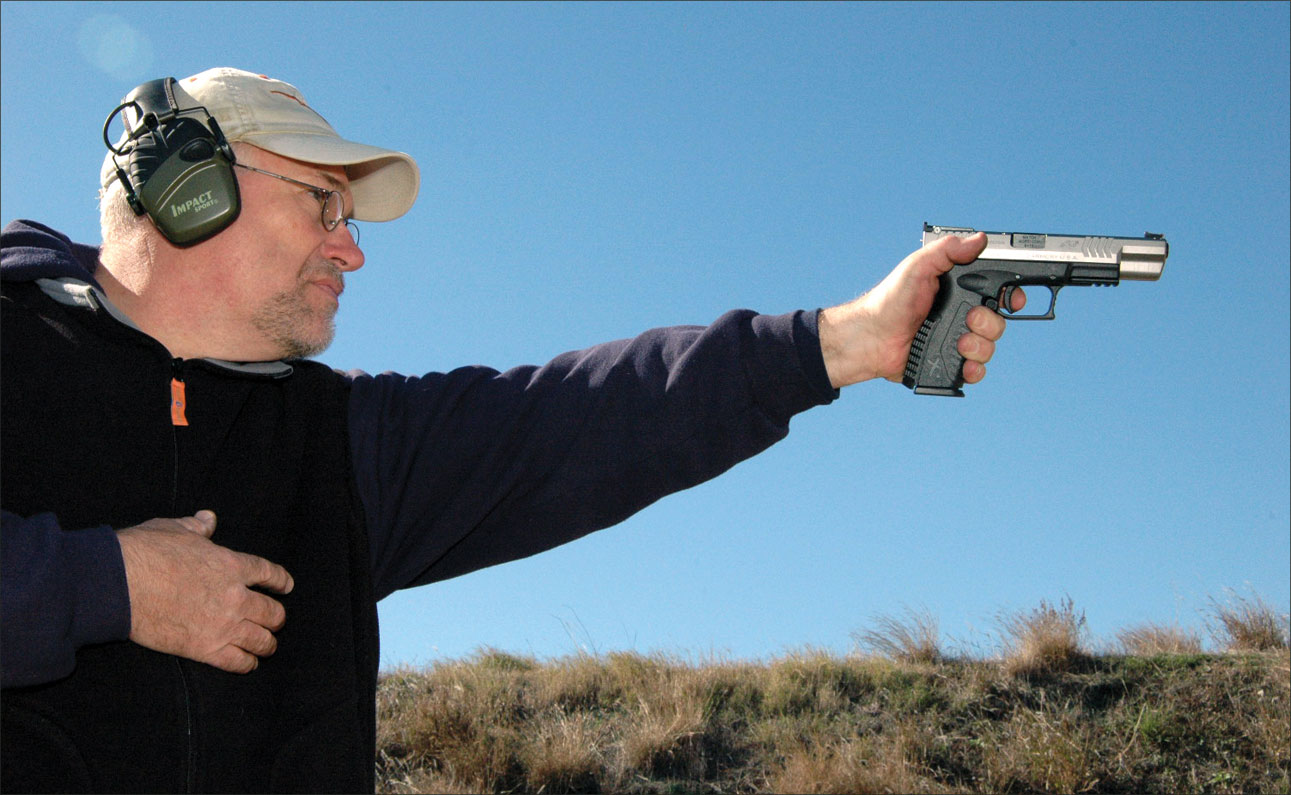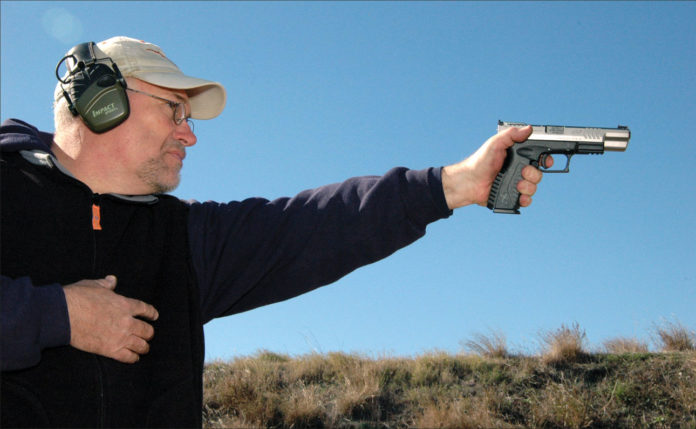We recently undertook a project to have the Springfield Armory Custom Shop upgrade two pistols – a process we believe many shooters have wondered about. What enhancements can any manufacturers custom shop deliver over and above what shooters get out of a stock pistol? Are the differences noticeable? Can an individual shooter appreciate the changes? And, finally, are the upgrades worth the coin?

We chose two pistols to put through a before-and-after process: a 9mm XDM 5.25 Competition previously tested in the February 2012 issue and a 9mm XDM 3.8 Compact purchased for this evaluation. We chose the compact for a defensive pistol because this gave us the option of using a 19-round magazine or the supplied 13-round magazine that was shorter and made the pistol easier to conceal. The 19-round magazine was fitted with a sleeve to extend the grip contour to its normal length. Likewise, alternate-size backstraps and sleeves were supplied, and they could be mixed and matched to the preference of the shooter. The competition model offered a permanent full-length grip with alternate backstraps and shipped with three 19-round magazines. Modifications were carried out by the Springfield Armory Custom Shop under the direction of 2006 Gunsmith of The Year Dave Williams.
To collect baseline and follow-up data, we went to the range and fired a basic accuracy test from the bench with sandbag support. We shot the 5.25 Competition from the 25-yard line and the Compact model from the 15-yard bench with the full-length magazine/grip in place. We also fired an action test similar to the Double Tap test in our 2012 evaluation to see if improvements to the trigger would help us shoot faster. Beginning with sights on the center of an IPSC Metric paper target placed 10 yards downrange, we fired two shots as fast as we could. Runs resulting in hits landing in the 5.9-inch by 11.15-inch A-zone were deemed acceptable.
Test rounds were the 115-grain FMJ by MagTech, 115-grain JHP EXP and 124-grain JHP +P rounds from Black Hills Ammunition, and 147-grain remanufactured Subsonic Match rounds by Atlanta Arms and Ammunition.
Lets see if we can justify an additional cash outlay with a measurable improvement in our speed and accuracy.
XDM 3.8 XDM9389CBHC
9mm Luger
For the 9mm XDM 3.8 Compact, we chose a Combat Action job for the trigger, the fitting of a fresh oversized match barrel, and an upgrade to Heinie Slant 8 tritium night sights. These sights include a slightly taller front sight with horizontal lines to kill glare. The rear sight face was also lined, but instead of the traditional two-dot design, the Slant 8 featured only one larger tritium module directly beneath the notch. We like this design because its simply a matter of putting the front tritium module beneath the rear module, forming the figure 8. Total cost for modifications to our XDM 3.8 Compact was $351.
This pistol has an MSRP of $705, and we found retail pricing for it as low as $515 (GunsInternational.com).
So the Custom Shop charges of $351 represent 68 percent of the purchase price.
Before shipping our test pistol to Springfield Armorys Custom Shop, we realized that this pistol was already a very good shooter. The budget MagTech 115-grain FMJ rounds shot 15-yard groups measuring about 2.3 inches across. The 147-grain Atlanta Arms and Ammunition printed 2.1-inch-wide groups on average. But the rounds we would actually carry for defense were more impressive. Firing the 115-grain EXP hollowpoints, our stock gun delivered 1.8-inch groups on average. The Black Hills 124-grain JHP +P rounds topped this with computed average-size groups measuring 1.6 inches across.
After being modified by the Custom Shop, the trigger press on our proposed carry gun was reduced from 6.0 pounds to 3.25 pounds. The distance the trigger needed to travel to the point of reset was shortened by half, from about 0.20 inches to approximately 0.10 inches of travel.
As you might expect, group sizes shrunk across the board. We found big improvement with the Black Hills 124-grain JHP +P rounds, with group sizes reduced by more than half, from an average of 1.6 inches down to 0.7 inches. In producing that 0.7-inch average, only one five-shot group measured more than 1 inch across. The Black Hills EXP rounds also were more accurate, shrinking from 1.8 inches to 1.1 inches in average group size. (What was more confidence inspiring was the power these two rounds produced. The 124-grain rounds generated 422 foot-pounds of muzzle energy. The 115-grain EXP loads were almost as powerful at 405 422 foot-pounds of muzzle energy. This is impressive performance for 9mm ammunition.)
The improved accuracy was likely a function of all three upgrades working together: a better barrel, lighter trigger, and easier-to-read sights. The question of how much the improved trigger press alone would help the shooter was answered in our action tests. What we were looking for was a consistent elapsed time that allowed us to get both shots inside the center of the target. Shooting the stock gun, we were able to deliver the two shots in an average elapsed time of about 0.55 seconds. The high and low were 0.61 seconds and 0.50 seconds, respectively. Split times were 0.23, 0.22, 0.22, 0.20 and 0.22 seconds respectively. This tells us that the take up for the first shot was uneven, forcing the shooter to concentrate on finding a way to break the shot with the sights on target.
After Custom Shop modifications, total elapsed time averaged about 0.44 seconds with variation high and low in the hundredths of seconds. This told us the trigger was more consistent than before. We also achieved split times consistently between 0.17 and .21 seconds. This may not seem like a huge advance, but the custom shop changes made us feel like we werent trying. Whereas we didnt feel we could shoot the stock gun much faster without sacrificing accuracy, the custom gun made it easier to shoot fast and keep our hits in the center of the target.
XDM 5.25 Competition
XDM95259SHC 9mm Luger
In our February 2012 test of the 9mm Springfield Armory XDM 5.25 Competition pistol, our only complaint was that we wanted to make it a faster shooter. The distance we had to press the trigger and then find the point of reset seemed excessive. Reset happens after a shot is fired and the trigger is released. While most trigger jobs focus solely on reducing the amount of physical resistance that the shooter must overcome to break the shot, the speed of any follow-up shots can be limited by the time it takes for the trigger to be reset.
The adjustable sights on the 9mm XDM 5.25 Competition model were already superior, so modifications were limited to a barrel upgrade and a Competition Action job. Total cost for modifications to our competition pistol was $416. Custom Shop prices are the same for both the private consumer and dealers alike.
This pistol has an MSRP of $865, and we found retail pricing for it as low as $710 at Sportsmans Outdoor Superstore. So the Custom Shop upgrade charges of $416 represent 59 percent of the unmodified guns price.
The stock competition pistol had a 4.75-pound trigger, which after Custom Shop tuning was reduced to 2.25 pounds. The distance the trigger needed to travel to the point of reset was shortened from about 0.20 inch to 0.10 inch.
Aside from the fact that the original barrel was returned, there was further evidence that the barrel had indeed been changed. The new barrel locked up with tolerance at the very limits of engagement. Retracting the slide and releasing it casually resulted in the slide stopping just short of it going fully into battery. In our bench test we sometimes saw a difference in point of impact between the first shot and the others that followed. Suspecting that the problem was caused by less satisfactory lockup when the slide was closed by hand, we then made it a practice of fully retracting the slide and letting it snap forward with all the force the recoil spring could muster as it picked up the first round. This solved the problem, indicating that the barrel fit was as tight as possible. What made us even happier was that both pistols shot without malfunction.
If the average sizes of the groups fired by the 5.25 Competition model seem comparable to the XDM 3.8 Compact, look again. This data was collected from the more challenging 25-yard bench. Springfield Armory Custom Shop personnel claim that groups should be cut in half. Indeed, the 115-grain JHP EXP rounds grouped at about 1.8 inches across from the stock gun, but almost all of our groups from the custom gun measured less than one inch across. Final computed average was in fact, 0.9 inches. We picked up a half-inch of accuracy firing the 115-grain MagTechs and saw 0.8 inches of improvement firing the 124-grain JHP +P rounds. All in, the custom gun improved from a respectable 2.1-inch five-shot average group to a consistent average group size measuring 1.3 inches.
In the action test, total elapsed time from the stock gun was consistent, but not spectacular. The average elapsed time for both shots computed to about 0.52 seconds. We did manage one split time of just 0.19 seconds, but the remaining elapsed times between shots were in the 0.25-second range. Firing the customized XDM 5.25 Competition, we reduced elapsed times to about 0.41 seconds on average, with much less variation from one run to the next. The big pickup was in the reduction of our split times. Elapsed times between shots one and two were 0.19, 0.17, 0.17, 0.12, and 0.18 seconds.
Our Team Said
XDM 3.8 XDM9389CBHC 9mm Luger Custom Shop Upgrades: Combat Action trigger job, oversized match barrel, Heinie Slant 8 tritium night sights. We asked for a refit of the original barrel, but the shop no longer adds material via TIG welding before reducing the bearing surfaces to fit tightly into place. Oversize replacement barrels are now available. This allows the shop to focus on hand-fitting, therefore reducing turnaround time. The Heinie Slant 8 sights proved fast and clean. The slant helps fight glare in addition to its grooved faces, and in our view this unit is more rugged than the original equipment. The custom trigger made us feel like we were shooting a refined 1911.
XDM 5.25 Competition XDM95259SHC 9mm Luger Custom Shop Upgrades: barrel upgrade and Competition Action job. The lighter trigger with a shorter reset was well worth the money. The new hand-fitted barrel did improve accuracy.
If you can only afford one modification, we recommend the trigger jobs. Here are Springfields pricing for various upgrades broken into components: XD/XD(M) Combat Action Job, $145; XD/XD(M) Competition Action Job, $195. We did see accuracy improvement across the board, but its difficult to say whether the trigger or barrel produced the most gains: Install Springfield Custom match barrel, $190.
The sights on the 5.25 were satisfactory as they came. The 3.8 was easier to shoot with the Heinie set:
Heinie Straight 8 Slant Pro tritium night sight set (1 green dot rear, 1 green dot front), $129.
A full list of Springfield Armory Custom Shop pricing is available at Springfield-Armory.com/custom.
Written and photographed by Roger Eckstine, using evaluations from Gun Tests team testers. GT



























